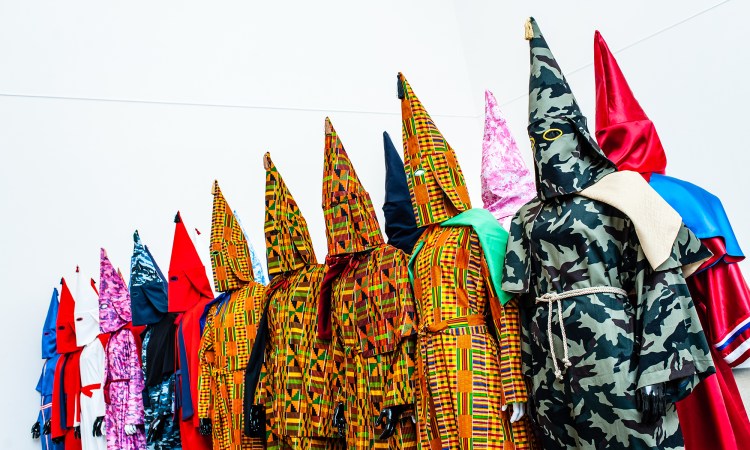
In April 2018, I flew to Vancouver, Canada, for my first TED Conference. As a TED Fellow, I had the opportunity to give both a talk and a cello performance. As I packed my artifacts and artwork, which included three of my custom Ku Klux Klan robes made from various fabrics, the one that most stood out to me then — and still stands out to me now — was the camouflage robe.
That robe represents the stealth aspect of racism: the everyday systems that discriminate but are often difficult to prove for what they are. Whether it’s housing, jobs, health care, banking or the prison system, systemic racism is sewn into every aspect of all we do — and its power lies in its ability to hide.
The past month has focused our attention, once again, on violence by police. This time it’s the deaths of George Floyd, Breonna Taylor, Ahmaud Arbery, Tony McDade and Rayshard Brooks — along with the countless others who’ve lost their lives because of the deep-seated racism and oppression that permeates American society.
I make art as a way to spread knowledge, empathy and understanding, but art has its limitations, just like every other sector. As the protests continue on our streets, I’m hopeful that we also continue to protest both the camouflaged and blatant forms of racism in all facets of our lives: our virtual meetings, our classrooms and whenever we see a lack of representation from Black lives.
As a self-proclaimed civilized society, we need to understand that economic violence is the most socially acceptable form of racism. This can take the form of restricting access to financial resources, education or the labor market, as well as restricting access to natural resources such as safe drinking water like in Flint, Michigan.
The workplace: If the only Black coworkers in your office are janitorial staff, security or cafeteria workers, know that this matters. Economic oppression comes in many forms, including the denial of opportunity. This is a form of terrorism that must be addressed during this uprising. As a former janitor and security guard, I’ve worked at institutions that didn’t have a single Black employee across the entire administrative floor. Examine your boards, your C-suites, your hiring process, the teams you manage. Who are the decision makers?
Education: I’m hoping the protests continue when you see a lack of representation from Black lives in your classrooms when you return to school. Part of this journey of resistance is acknowledging that we have intentionally segregated our schools, neighborhoods and workplaces. These disproportionalities heighten the disparities in opportunity. This imbalance can no longer be ignored. We’ve normalized it, but this atrocity warrants additional protests and continued action.
We can feel bolstered by hopeful changes in legislation here and there, but don’t raise the “V” for victory too quickly. Four hundred-plus years of oppression is not going to be wiped out in a few weeks or through a few months of resistance. If history has taught us anything, it’s that the tendency of the oppressor is to double down.
The historical precedent: The last major pandemic in 1918 was followed by race riots and massacres in more than 36 cities in 1919, in what’s now known as “Red Summer.” That year’s violence was among the first in which a white mob attacked a Black community, and Black people fought back in large numbers.
It’s easy to see a parallel between then and now. Many point to potential positive outcomes of what the COVID-19 pandemic has exposed and this year’s global protests against police violence. But there should be caution along with the optimism and action.
Following Red Summer came the Black Wall Street massacre in Tulsa and other forms of retribution: the passing of the Johnson-Reed Act of 1924, the banning of Chinese immigration and imposition of severe quotas, and the rise of the second wave of the Ku Klux Klan. Unintended consequences of today’s events could include the strengthening of white supremacy — unless we continue to intentionally, and thoughtfully, fight it.
During this moment and moving forward, I’m encouraging an inclusive and authentic plan that will ensure this significant moment and opportunity in history is not lost. This will require more than Truth and Reconciliation, or copious amounts of antiracist training (though it does require that too).
The shift will have to be in genuine awareness that the systems we live in are designed to help some and harm others. They are built to be brutal and detrimental, stealing the growth, opportunity, wealth and well-being from one population to reap benefits for another.
The way forward: Fully informed and factual education needs to be reflected in our school curriculums, from preschool through to graduate programs. Every class — from ethnomusicology to criminal justice, med school to MBAs — must address the systemic and structural policies that permeate each and every one of our industries. There’s not a single class that would not benefit from examining the systemic and structural racism within its subject matter. There’s not a single office that couldn’t stand to be examined and asked to do better. There’s not a single meeting where we can afford to stop these protests and conversations.
The protests in the streets must now move into our meeting rooms, classrooms and gatherings of all kinds, where racism sits comfortably incognito and in camouflage, where it has, until now, been normalized and accepted. We must continue the protests beyond the streets to where they are needed the most: everywhere.
Watch his TED talk here:












